Pool Builder
Ryan Hughes on Creating Outdoor Living Spaces

Ryan Hughes has built a career out of working with some of the most discerning homeowners in Tampa, Florida. Having established a reputation for creating exceptional outdoor living spaces, Hughes continues to set the bar higher and higher in the industry. We had the opportunity to catch up with him at the International Pool & Spa Expo in Dallas recently. During the course of our conversation, we got to learn a little bit more about his process for conceptualizing resort-style backyards for high-end custom homes.
Transitioning To An Elite Design / Build Firm
Stepping into a thriving landscape design business, for Hughes, the pathway towards becoming an elite designer really began in earnest when he rebranded his family firm from The Hughes Group to Ryan Hughes Design / Build.
While widely known as an expert in the field of pool and landscape design, the award-winning designer is also a licensed pool builder holding a State of Florida Certified Pool Contractors License. Hughes explained that the rebranding process was an essential turning point that allowed him to reach the next level and connect with more affluent homeowners.

Designing Outdoor Living Environments For The 1%
“We create better lifestyles through innovative outdoor living,” said Hughes, when describing his firm’s mission statement. As the go-to designer for the elite 1% in Tampa, Hughes says creating a better experience for customers is paramount.
Hughes, who certainly didn’t start off building million-dollar backyards, says that it was a lengthy learning process to get to that point in his career. “In 2008, I got a chance to sit down and reflect on why I wasn’t connecting with the top 1%,” said Hughes, “I realized a few things, for one, I was focused on design and construction and I wasn’t focused on the client experience. I didn’t even know what that meant. I needed to educate myself on how the top 1% buy,” he explained.
“I also realized something even more important,” said Hughes, “and that is the (profit) margins. The margins I had prior to 2008 were from my father’s business or what I had learned from other folks in the industry. If you’re trying to do something exceptional you can’t mimic other people,” explained Hughes who said that it’s not enough to be able to sell to the 1%, you also have to be able to build these projects profitably. The second point is the more difficult aspect, which builders have a tendency to struggle with.

Scaling For Growth During The Pandemic
Like many in the industry, Ryan Hughes Design / Build has grown in the last two years in part due to the increased demand from consumers looking to enhance their backyard during the pandemic. With the virus curtailing travel and limiting the number of options on where to put those discretionary dollars, homeowners are reinvesting in their homes. Being confined to the home during this time put a renewed focus in the minds of consumers to create an outdoor living experience that the entire family could enjoy.
“The economy already started to heat up in 2017 so we were already preparing for some pretty big growth, we were ready for it, and then, of course, Covid hit and we got a little nervous,” said Hughes who recalled some hard discussions with his wife during the depths of the pandemic.
Covid-19 Creates A Deciding Moment
“We were discussing whether we wanted to expand or retract and we said ‘let’s keep going’ and started recruiting even faster than we were,” said Hughes, “Wow, did we time that right, because then all of a sudden things went the other direction with Covid and the demand has gone through the roof.”
Hughes, who is busier than ever says he currently has a two-year backlog to get through what he has already sold. “The leads are still coming in,” said Hughes, “we’re up to a six-month wait time so if someone signs a design contract, they’re waiting six months before we can even start the design.”
How Industry Price Increases Have Impacted Fixed Cost Pricing
Like many, Hughes was impacted by the recent surge in price increases. During the pandemic, a perfect storm of factory closures, workforce cutbacks, logistical delays, and a deep freeze in Texas which took a large percentage of equipment out of circulation, helped set the stage for increases across the board. An explosion at the BioLab plant which is responsible for a large percentage of dry chlorine products sold in the U.S. contributed to increases from the chemical side as well.
“In the early parts of 2021 we were victim to price increases,” said Hughes, “we do fixed cost contracts with our clients so we had to honor them, but because I keep the margins high, I was able to do that. I didn’t have to go back to a single client and say that we were over budget and needed more money,” he explained. “There was probably around 6 months and 8 or 9 projects that we did for practice because the margins crushed us.”
Every Challenge Creates Oppportunity
“We’re doing some creative things now,” said Hughes, as he described how he is dealing with any further anticipated increases. “With every challenge, there is always an opportunity. One of the things my father taught me as he went through the inflation in the ’70’s, he said if inflation hits, buy inventory,” explained Hughes, “We bought a very large warehouse and I just talked to Jandy; we’re buying as many pumps and heaters as we can fit.”
In explaining the strategy against hedging against inflating prices, Hughes said, “If things keep going up in price, we may actually make money because we’re buying it at today’s prices. I think doing fixed cost pricing in this environment is risky, but we’ve somewhat mitigated that with what we’re doing.”

Creating a World-Class Client Experience
As one of the foremost experts in his field, we asked him what the 1% want in their backyards. We wanted to know what features and design amenities are trending with high-end homeowners in the Tampa market. “It’s a tricky question,” said Hughes, “because we do things a little differently. We don’t go out to a client and interview them and ask them what they want. We try and find out who they are.”
The Secret To Satisfying Your Client: Over Deliver
“It’s about creating a world-class client experience and how do you do that? You over-deliver,” said Hughes. “If you don’t have the right margins, you can’t over-deliver. That is the number one lesson that I can share with builders who want to get into the multi-million dollar market.”
Hughes says that blowing away the client’s expectations is the secret sauce that has propelled him. He feels that this above all is the differentiating factor that has made him the designer of choice on so many high-end projects throughout his career.

Connecting With The Clients Lifestyle
In trying to create that profile for the design process, Hughes stresses the importance of connecting with the client’s lifestyle. “We interview them to find out what kinds of things they like. Where do they eat dinner? Where do they travel? What kind of car do they own? What kind of wine do they drink? I ask them to describe in detail the kind of party they would throw.” said Hughes.
Custom Tailored Versus Off The Rack
For that exclusive 1% clientele, bringing in a high-caliber design firm to connect with their lifestyle is the equivalent of going in for a finely tailored custom suit rather than buying off the rack. Hughes says he places enormous emphasis on building that profile when planning an outdoor living project.
Telling The Customer What They Want
“We’re asking them who they are and then tell them what they want,” he explained, “No one comes to us and says ‘I’d like a vanishing edge pool with a side of fire bowls. They just don’t know and maybe what they’re asking for doesn’t even fit their lifestyle. We’re very in touch with the trends, but it is our job to tell them what is applicable for their project.”
“We try to figure out which elements contribute to that lifestyle component,” said Hughes, “if someone is looking for that over-the-top party environment, there’s going to be more fire, more color-changing LED lights. The acrylic windows may come into play, but it all depends on the client.”
“To make the backyard an experience, you have to create a feel that connects with the client.”
Ryan Hughes – Ryan Hughes Design / Build
Creating The Right Atmosphere
“A lot of people talk about architecture and art but what’s the end result, it’s about a feeling,” said Hughes, “When you go to a really cool restaurant, you don’t talk about the architecture. You say ‘wow, this atmosphere is amazing.’ The same thing holds true if you go to a boutique hotel and spend thousands of dollars a night on a room, it’s about the atmosphere and the vibe you get from the experience.” said Hughes. He indicated that those elements collected during the profiling stage often dictate what that vibe and feel will resemble in the overall design plan presented to the client.
Space Planning Around Functionality
Hitting all of the personalized notes that create a truly custom-tailored experience for the homeowner is a process Hughes is all too familiar with. He indicated that many builders approach the space planning around the pool which is the opposite approach he takes when planning an outdoor living space that caters to the customer’s lifestyle.
“We start with functionality,” said Hughes, “We don’t even really start with the swimming pool design. We start with the overall space planning and create the destinations. So we say we’re going to have a lounge area here, and a social firepit there. We’re going to add an outdoor kitchen and a dining scenario as well. We’re mapping that out before we even start to conceptualize what the pool is going to look like,” explained Hughes.

Expansion Into The Orlando Market
With a few new exciting projects coming out this year, Hughes is focused on expanding his footprint in Florida. “We recently expanded into the Orlando market and we have a couple of big lazy rivers over there. Our average lazy river is around 200 feet, this one we’re doing is 300 feet long. It has some really interesting water features and a cantilever pavilion that goes over the river. As you go through the river it’s got a water column that Crystal Fountains manufactured for us that’s going to put 500 gallons a minute of water down on you as you’re tubing through it. This one has amazing lighting, acrylic, and fire. It’s got everything that we’re known for but on steroids.”
That certainly isn’t the only high-end project Hughes has going in the Orlando market. “There is an indoor pool that we’re doing. It’s a 100-foot lap pool on the side of the house and adjacent to it is a Koi pond that runs the entire length separated by only by acrylic so you’re literally going to be swimming laps in the pool with the fish.”
The average price for one of Ryan Hughes’s builds has certainly gone up since he transitioned to focusing on the client experience. These days the size and scale of projects he works on have gone up in correlation with the prices he charges. “In ’08 we were at that 250-350k range, our average job cost now is around $1.5 million. Our projects in Orlando are $3-5 million residential projects. The size and scale have really gotten fun.”
Watch our entire interview with Ryan Hughes at the International Pool & Spa Expo
Features
The Growing Popularity of Reinforced PVC Membrane for Repairing and Restoring Residential Pools

Reinforced PVC membrane is a proven European solution that is rapidly picking up speed in the United States. This gorgeous, reinforced PVC membrane pool finish has the appearance of slate, marble, granite, sand and even traditional gunite. Reinforced PVC membrane is rapidly growing in popularity among pool professionals for renovating residential pools. Here is what pool builders and pool renovators need to know about this trending material and why they should offer it to their customers for both pool renovations and new construction.
Offering a reinforced PVC membrane pool finish
One of the main advantages of reinforced PVC membranes is that they don’t crack regardless of freeze-thaw conditions or ground movement. Therefore, offering a reinforced PVC membrane provides a pool finish with unique benefits not provided by marbelite, stone-colored quartz finishes or thermoplastic coating. The reinforced PVC membrane completely seals the structure of the pool and keeps it watertight, making it ideal for renovating existing pools and building new pools. Reinforced PVC membrane is the perfect renovation product for pools with peeling paint, cracks, or leaking gunite and plaster. Using reinforced PVC membrane will break the cycle of constantly repainting or costly replastering of the pool surface. In fact, pool professionals can distinguish themselves from competitors by offering a more comprehensive pool repair and restoration. Offering this long-lasting, reinforced PVC membrane can become a lucrative addition to your business providing an invaluable and profitable renovation option for a comprehensive pool repair.
Designer colors and textures

Today’s booming interest in this product for residential pools can be largely be attributed to the expansive colors and textures of reinforced PVC membrane that manufacturers like RENOLIT, in their TOUCH and VOGUE collections.

Consumers are drawn to the many new colors and finishes that give pool a high-end, designer look. For example, RENOLIT TOUCH series has colors and finishes that enhance and blend beautifully with today’s popular decking and coping treatments. The colors and textures offered by RENOLIT range from dark, grey slate and white marble finishes to speckled gunite and sand finishes. Buyers appreciate the materials high-quality and longevity inherent in the thicker 60, 70 and 80mil reinforced PVC membrane making it the perfect pool finish for pool professionals to add to their offerings.
Training

One, reinforced PVC membrane manufacturer, RENOLIT offers training and assisted installations to builders and installers getting started with learning the welding techniques for installing reinforced PVC membrane. In fact, installing reinforced PVC membrane is easy, and there are very low barriers to entry. No expensive equipment is required for installation and pool professionals can simply order the needed rolls and accessories for each job.
Once installation crews know how to install reinforced PVC membrane, they will find they are always busy and always in demand. Having the skill to install reinforced PVC membrane opens new opportunities for additional work in off-season. Residential installers equipped with this new set of skills find themselves expanding into commercial markets including hotels and motels where they can renovate indoor pools throughout the winter.
Growing demand of reinforced PVC membrane

The introduction of new architectural patterns and textures such as the RENOLIT TOUCH series has contributed to the growing demand for reinforced PVC membranes. The new finishes imitate the look and feel of natural elements giving pools a high-end, designer look. It’s a high-quality premium product with a different price point that works for those that want to spend more for a long-lasting, attractive pool. By adding designer reinforced PVC membranes to their offerings, pool businesses can distinguish their business from competitors and expand their market.
Visit RENOLIT to learn more about designer reinforced PVC membrane, their new selection of finishes in various, colors and prints and sign up for installation training.
Contractors and Builders
Plungie Pools: A Turn-Key Solution For Builders & Consumers
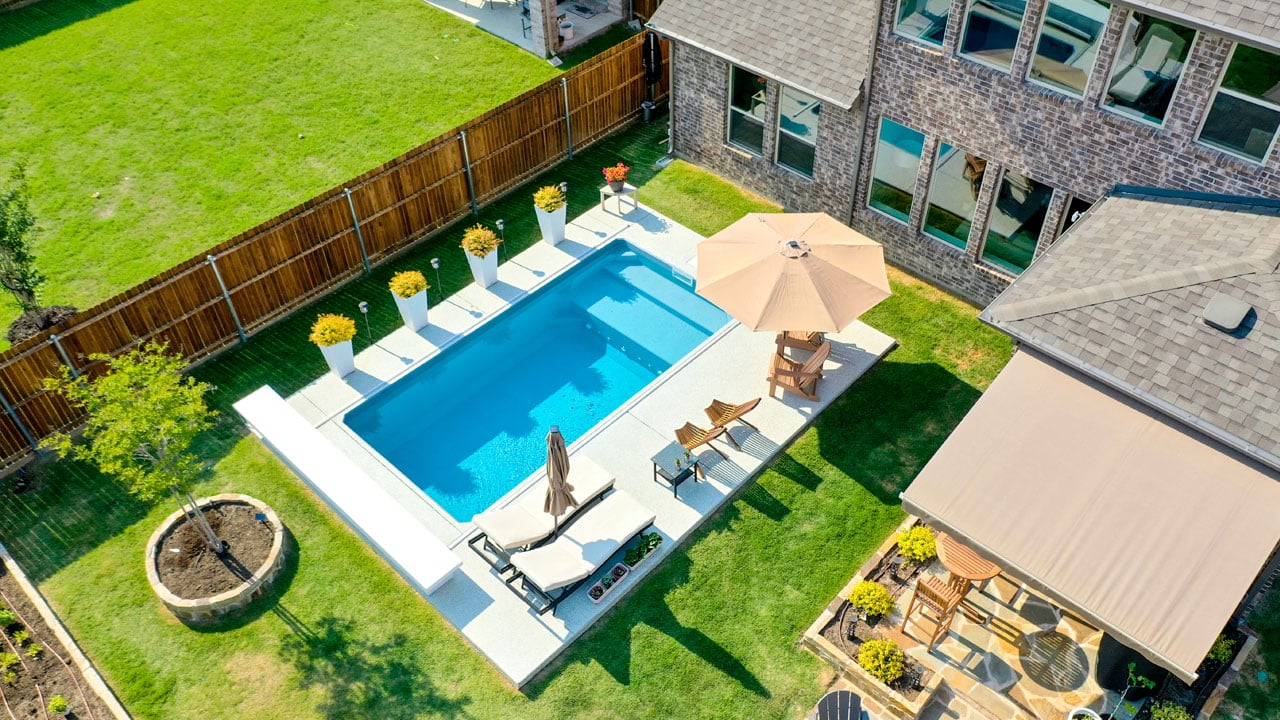
In an industry where speed, quality, and sustainability are paramount, Plungie is getting increased attention with its precast concrete pools. Aimed at pool builders, developers, and homeowners looking for smart turn-key solutions, Plungie pools offer a compelling alternative to traditional gunite, vinyl liner, or fiberglass options. During a recent interview with Cam Levick and Mike Walter from Plungie, Pool Magazine explored what makes these pools revolutionary—and why they are quickly gaining market share as the go-to choice for savvy professionals and eco-conscious consumers alike.
Plungie Pre-Cast Concrete Pools
According to Cam Levick, the story behind Plungie is both simple and exciting. “Our core founders, one is a traditional pool builder, and the other is a guy who just loves concrete and inventing things,” he explained. Six years ago, the team came together with a shared vision: creating a faster, more efficient way to build pools. The result was Plungie, a monolithic, precast concrete pool that could be installed in record time.
Plungie’s journey started in Australia, where they sold thousands of pools, and has since expanded into the U.S. market, providing the same high-quality product that has taken off across both continents.
Unlike traditional pools that require weeks or even months to construct, Plungie pools are factory-built and ready for installation within 10 days. “The pool industry has always been bogged down by delays—curing time, weather interruptions, and subcontractor availability,” Levick said. “With Plungie, those headaches are gone. Our pools come ready to install, so you can complete the project faster and with fewer disruptions.”
What Sets Plungie Apart?
One of the critical differences between Plungie and traditional pools lies in the construction method. Levick emphasized that all Plungie pools are built in a factory controlled environment, giving them a competitive edge over gunite and shotcrete pools. “Our lead time is 10 days,” he noted. “Because we build in a factory, our environmental footprint is much smaller, and we use 8000 PSI concrete, which is stronger than what’s used for gunite or shotcrete.”
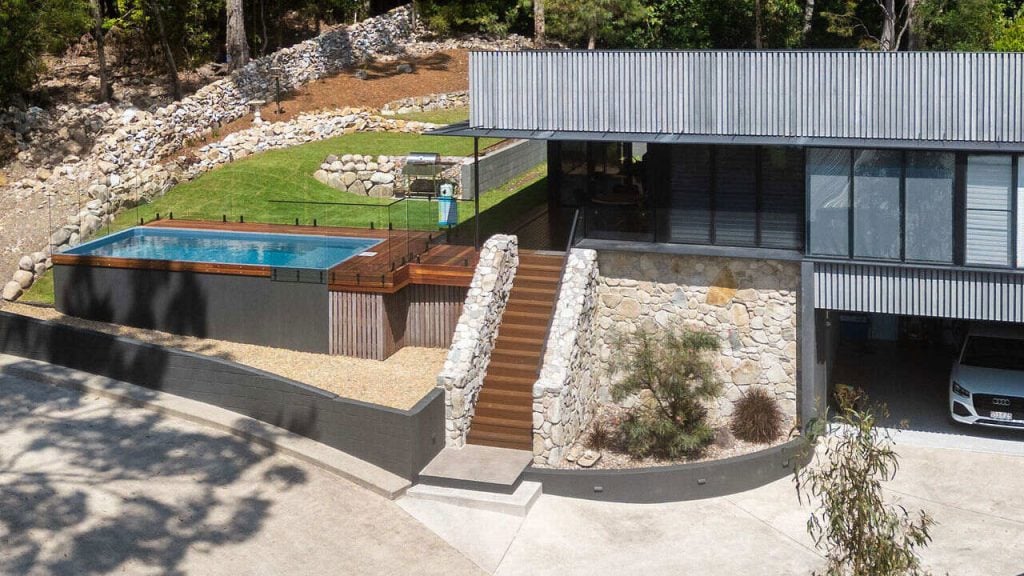
The precast design offers incredible versatility for homeowners with limited space or challenging terrain. “They can go above ground, fully in-ground, or even act as retaining walls,” Levick shared. This flexibility, combined with industry certifications like ICC and UL approvals, gives builders and homeowners confidence in the durability and quality of Plungie pools.
The Product Line: Something for Every Backyard
Plungie offers four flagship models to meet a variety of needs and preferences. Mike Walter elaborated on the different pool models:
The Max: 20×10 feet, holding 5,300 gallons of water, ideal for larger backyards.
The Original: 15×8 feet, with a 3,200-gallon capacity, balancing size and function.
The Studio: A compact 12×7-foot pool, perfect for urban settings or smaller spaces.
The Arena: An 11.5-foot circular pool, offering a distinctive, design-forward look.
In addition to the standard features, each Plungie pool comes pre-plumbed, pre-lit, and eco-finished with a 10-year warranty on both the shell and finish. “It’s a truly turnkey experience,” Walter said, adding that the pools also feature umbrella holders and hydrostatic valves to enhance convenience and functionality.
Performance That Builders and Homeowners Will Love
Beyond sustainability, Plungie pools outperform fiberglass pools in several key areas. “Concrete pools retain heat better than fiberglass, so they’re more energy-efficient,” Levick pointed out. “It’s easier to maintain your desired water temperature, whether you’re heating or cooling the pool.”
Levick also highlighted the durability and feel of concrete, which many homeowners prefer over fiberglass. “There’s just something about the feel of concrete that people love,” he said. “And with our monolithic pour—where the pool is cast in a single piece—there are no weak points or cold joints to worry about. That’s why we offer a 10-year warranty on both the shell and the finish.”
Plungie’s partnership with EcoFinish adds another layer of quality to the product. “EcoFinish is a high-performance polymer that bonds chemically and physically to our concrete,” Levick explained. “It’s easy to maintain, resistant to chemicals, and incredibly durable. Plus, it comes with a 10-year warranty, just like our pools.”
Sustainability at the Core
Sustainability is a key focus for Plungie, a point Levick was eager to elaborate on. “Building products don’t always have the best track record in terms of sustainability,” he admitted. “We wanted to take a proactive approach.” Plungie conducted a life cycle assessment comparing its pools to traditional concrete pools. The results were striking:
“We found that a Plungie has a 41% lower carbon footprint than a traditional on-site pool,” Levick said. “And in some cases, with recent changes, we’ve been able to reduce that footprint by up to 60%.” Plungie pools require fewer site visits and less concrete, and they can even be recycled at the end of their life—a feature not feasible with fiberglass pools.
Why Choose a Plungie Pool?
When evaluating pool options, Levick explained, many consumers appreciate the thermal and aesthetic benefits of concrete. “Concrete pools retain heat better than fiberglass, making them more energy-efficient to maintain the desired water temperature,” he said. Additionally, customers enjoy the durability and feel of concrete, which adds a layer of quality that fiberglass often cannot replicate.
Walter highlighted another benefit: Plungie’s speed of installation. “Homeowners can plan their pools on our website, connect with an installer, and have a pool in place within days, not months,” he said. This efficient process appeals to builders and developers alike.
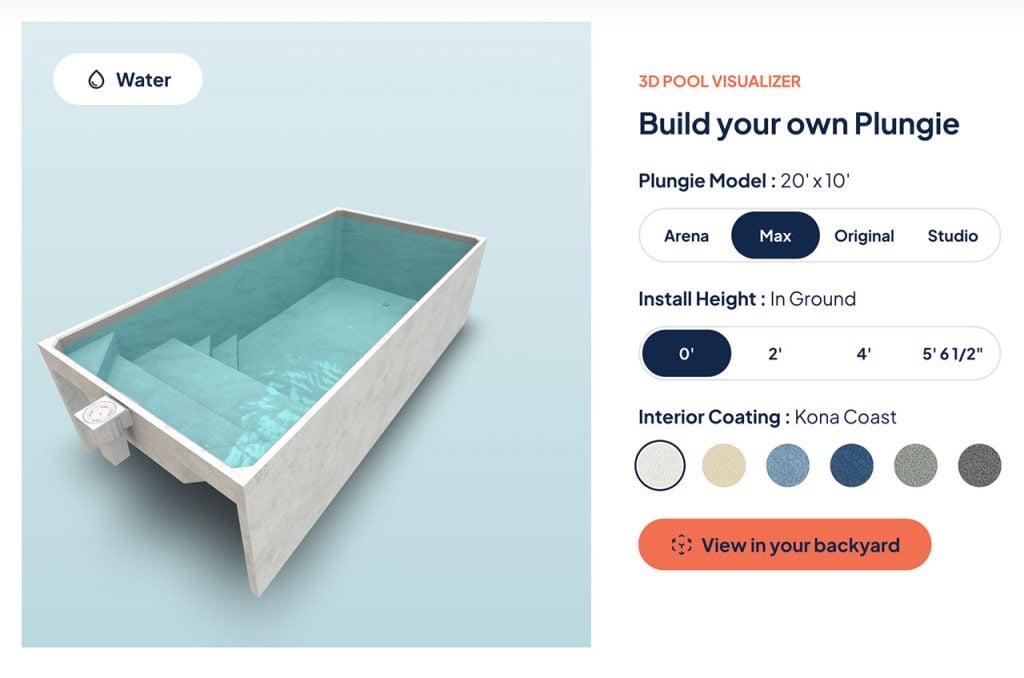
Scalable Solutions for Developers
The ability to scale production is one of Plungie’s greatest strengths. Walter shared that Plungie’s approach has made them popular with homebuilders. “We’re currently working with a builder developing 1,600 homes. He’s planning to install 400 Plungie pools across the subdivision,” Walter revealed. “Because our pools are quick to install, builders can place a pool, finish the house, and sell it without delays.”
Keeping the entire process in-house—from excavation to installation—offers builders greater control over project timelines and profitability. “The margins are much better when you’re not outsourcing to subcontractors,” Walter noted.
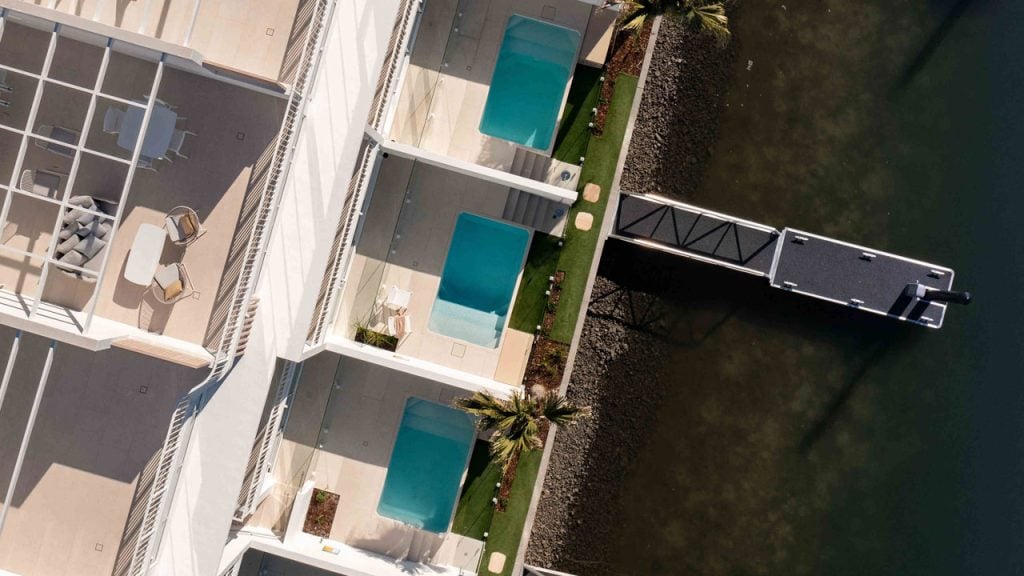
A New Way Forward for Pool Professionals
Mike Walter explained that for value proposition for builders lies in Plungie’s speed, scalability, and quality, making it easier to meet tight deadlines and manage multiple projects. For homeowners, it provides a sleek, modern pool without the usual hassle of lengthy construction timelines and disruptive on-site work.
“Builders don’t need to worry about rain delays or subcontractor availability,” Walter emphasized. “With Plungie, they can plan their projects more efficiently, keeping everything on schedule and under budget.”
Levick added, “For developers and architects, Plungie offers a way to stay ahead of the curve. Our BIM content helps architects calculate the environmental impact of their projects, and our modular pool designs make it easy to customize installations.
Filling an Important Gap
Plungie pools aren’t here to replace custom pools but to fill an important gap in the market, offering a smart, practical option for both builders and homeowners. As Mike Walter explained, “There are a lot of cases where customers want a custom pool, but because of site challenges like slope or grade, they just can’t do it. Or, it might cost them a tremendous amount of money to build that pool the way they imagined.”
Plungie pools provide an alternative that works in a range of situations where a custom pool might be out of reach or impractical. “We offer the next option for them—something that’s going to be more affordable,” Walter continued. “It’s going to help the customer save money, reduce damage to their yard, and limit the amount of foot traffic during installation.” For homeowners, this means getting a pool without the usual stress and disruption.
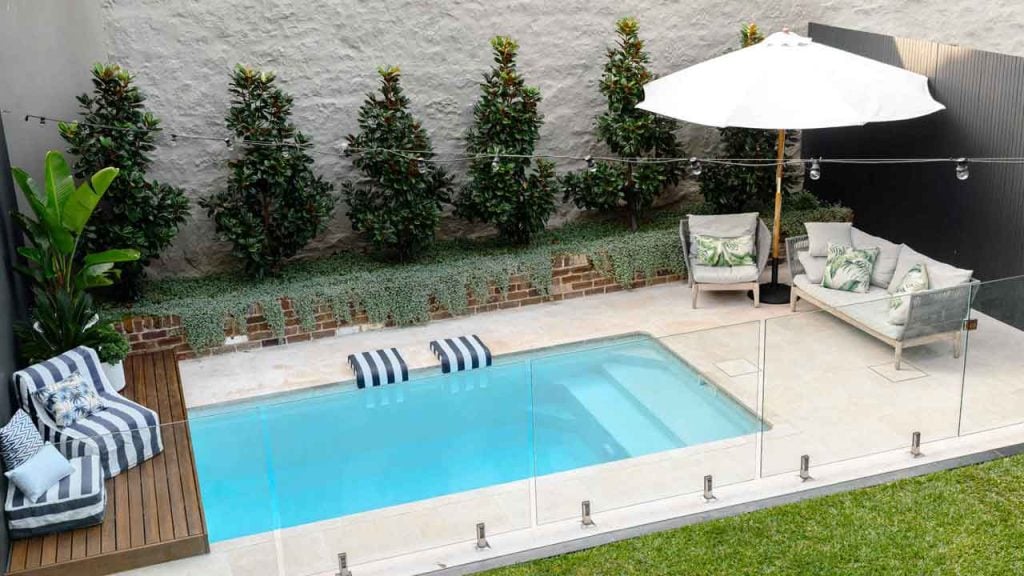
For pool professionals, Plungie is an essential tool to stay competitive and meet the evolving demands of today’s customers. “It’s just another arrow in their quiver,” Walter said. “They aren’t giving up custom pools. Instead, they now have a solution that lets them offer something equally impressive, but more accessible and affordable.”
Cam Levick also suggests that in the face of rising material costs, labor shortages, and growing environmental concerns, Plungie’s monolithic precast pools provide a streamlined solution that benefits everyone involved. “Builders appreciate the short installation timelines and reduced costs, while homeowners love the eco-conscious design, flexibility, and durability:.
“We’re not just selling pools,” Levick added. “We’re providing peace of mind—whether for a homeowner who wants to enjoy their pool in days, not months, or for a builder who needs a reliable product with fewer delays and complications.”
Ready to take a deeper dive?
Listen to our entire conversation about Plungie with Cam Levick and Mike Walter on the Pool Magazine podcast.
Pool Builder
Navigating Manufacturer Relationships: How To Get The Support You Deserve

Have you ever felt helpless with equipment manufacturers? Felt like you were getting the go around and not feeling supported? Or that since you are not a big enough number, so you do not get support on products!?! I will be completely honest; I have felt at times my issue with manufactures were downplayed because I do not buy as much equipment as a competitor who has 900+ pools. I have even felt like larger companies who do not purchase much from one equipment manufacturer were getting better tech support benefits. I think everyone one of us have felt that way toward one manufacturer or another. However, what are some ways to get the support we deserve?
In the pool industry, like many others, we believe customer service is key. It is one of the main reasons we use a particular manufacturer’s equipment.
“It’s on the manufacturer to be tight with their customers and anticipate issues before they happen and ensure strong upfront communication … but when things do happen, the sales rep should do all they can to proactively engage, understand the issue and resolve it. The sales rep should have a caring heart. If you care customers notice it and makes the process much easier,” Jason Anderson Senior Regional Sale Manager with Fluidra commented.
What should we do when we feel we are not getting the support we need?
Documentation
Documentation is important when you feel you are not getting support. Making sure to document every call, text and email. When you have documentation on the communication and solution you are not getting, it will help you have a professional conversation with the manufacturer’s reps or superiors.
Attend Trainings
Most equipment installation issues can be resolved by attending manufacturer trainings. You can attend these classes either at regional trainings, conventions, or local tabletops. Not only are manufacturer trainings important to give you the information you need to install and troubleshoot equipment, but it is away to build relationships with the reps in the area. Training sessions can also give you opportunities to meet other pool professionals with knowledge of the equipment, including who the warranty stations are. When you are troubleshooting or in a bind and need advice, calling the warranty station can be a great resource.
Networking
The best advice I was ever given while learning the pool industry was networking. Building professional relationships with other pool pros allows you to have a circle of people who know the trade and bounce ideas with. You have an outside resource from the pool manufacturers. Believe me, there have been many times I would call a colleague in a unique situation, and they were able to give me the tips and tricks to solve my dilemma. I have, also, experienced having another set of eyes or ears helped me see something I was overlooking.
Explore other Reps
Hey, it is human nature to not mesh with everyone. That is A-OKAY! That is why finding a manufacturer rep that you jive with is important. One thing we are lucky to have is multiple manufacturer reps in each region. They are divided up between technical and sales. Both can work with you for your needs. If you feel like you are getting nowhere with BOB, you can seek out JOHN. If you do not know who the other reps are in your area you can contact distribution, warranty stations and other collogues to give you their contact information.

So what do we do when we feel we have tried everything avenue to resolve our problem, if its faulty product, customer service, rebates, etc?
Start with contacting your manufacturer rep with an email documenting all the steps you have taken to resolve the issue and the results of those steps. In this email hold back emotional responses. Sometimes are emotions can get the best of us and cloud the factual component of our communications. People are more willing to work with you when they do not feel attacked. I would, also, recommend setting a timeline for a response. Be reasonable with thetimeline. You wantto give enough timeforthe rep to read, research solutions and respond.
What is the next step if you feel you have not received a better resolution?
In these cases, it is best to move your communication to management. Forward the email chain you have been using with your local rep. I would suggest keeping the local rep in the email. This allows everyone to be part of the issue and resolutions. I have found in more cases than not; my issues have been resolved by this step. With continued professionalism throughoutthe process, I have been able to still maintain professional relationship with the local rep even with elevating my concerns.
When do you say enough is enough and change manufacturers?
This is going to be a different moment for everyone. When you feel a manufacture isn’t resolving your issues and you do not want to sell their product that is up to you. However, keep in mind not every pool has the same brand equipment. You do not want to lose business because you only want to use one brand. I would recommend keeping the knowledge and skill set of every manufacturer. When a customer calls to fix something, if they have a different brand equipment, you can still fix the issue with the brand you may not prefer. If the customer asks for your recommendation, then you can suggest the manufacturer you feel gives the best customer service, with the best quality product. I have gone into many yards, where the customer has called other companies to help resolve issues. Yet, since they had certain brand of equipment and the companies do not install that brand, I won the customer and all their future work because I will work on all manufacture’s equipment.
Final Thoughts
Navigating relationships with equipment manufacturers can be challenging, but it’s essential to advocate for the support you deserve. By documenting your communications, attending training sessions, and actively networking with other professionals, you can create a strong foundation for collaboration. Remember that finding the right manufacturer representative is crucial—don’t hesitate to explore other options if you feel unsupported.
If you’ve exhausted all avenues and still feel let down, escalating your concerns to management can often lead to resolutions. Ultimately, knowing when to pivot to another manufacturer is a personal decision, but maintaining a broad knowledge of various brands can enhance your versatility and business opportunities. By staying open to all equipment types and prioritizing customer service, you can ensure your clients receive the best solutions, no matter their preferred brand. Embrace the journey, build those connections, and continue to grow in your expertise—support is out there, waiting for you to reach out and grab it!
-

 Trade Shows2 weeks ago
Trade Shows2 weeks agoPool Trade Shows & Industry Events To Attend in 2025-2026
-

 Pool Maintenance2 weeks ago
Pool Maintenance2 weeks agoNJ Municipal Workers Accused of Stealing Pool Chemicals For Their Own Business
-

 Pool Builder3 weeks ago
Pool Builder3 weeks agoBasin Pool Designs Has The Right Recipe For Creating Spectacular Luxury Pools
-

 Pool News4 weeks ago
Pool News4 weeks agoPool Tile, Coping, and Kickflips: The Unique Lifestyle of Thiago Dasilva
-
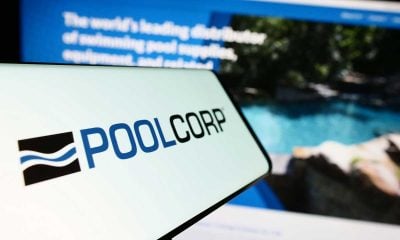
 Industry News4 weeks ago
Industry News4 weeks agoInsights with POOLCORP Vice President of Marketing, Kendall Large
-

 Contractors and Builders3 weeks ago
Contractors and Builders3 weeks agoInsurance Premiums on the Rise: How Pool Pros Can Stay Afloat
-

 Manufacturers4 weeks ago
Manufacturers4 weeks agoLatham Pools: Driving Innovation as They Approach a Platinum Milestone
-

 News3 weeks ago
News3 weeks agoAquaStar hires Jeff Cameron as Northeast Sales/Technical Manager









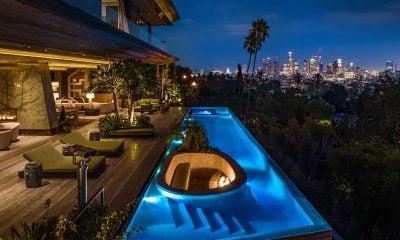


























[…] we enter into 2024, outdoor living trends continues to evolve, bringing new ideas and innovations to the forefront. From open […]